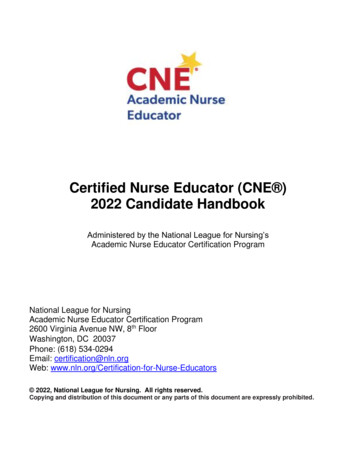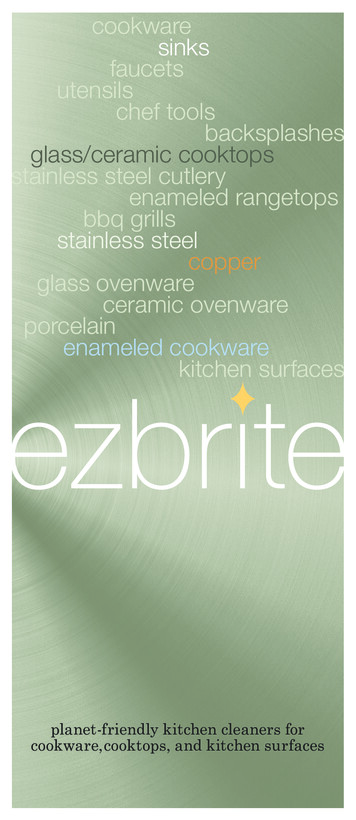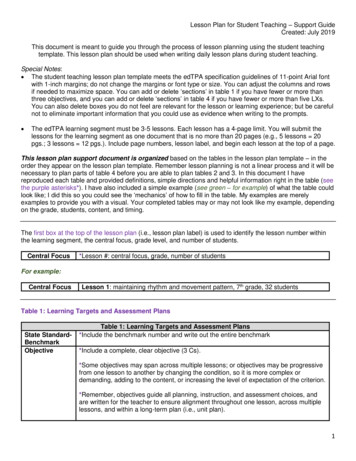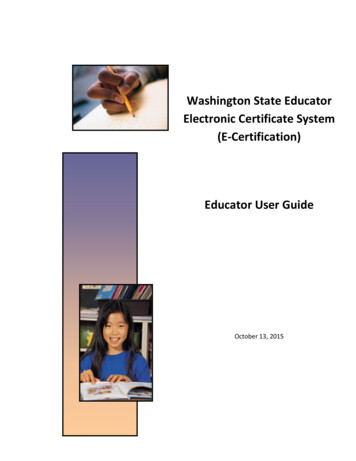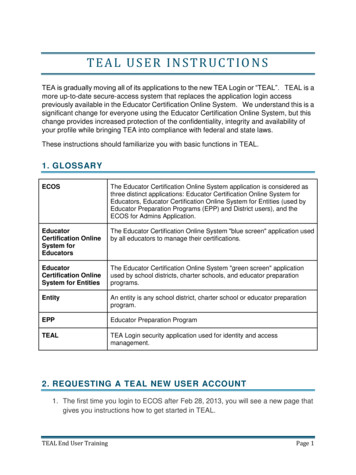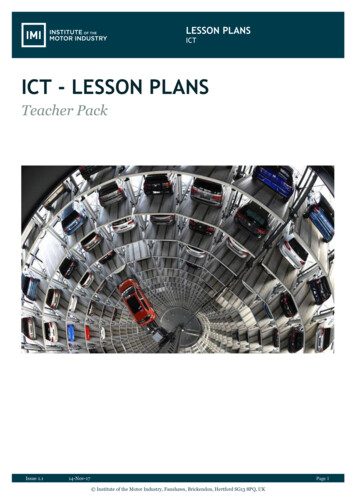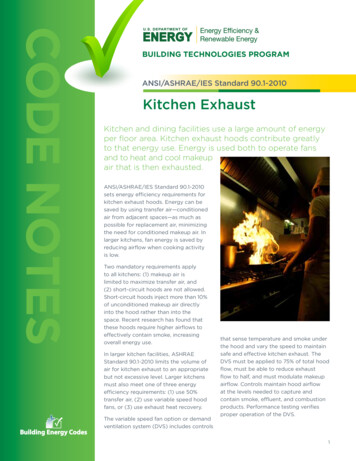
Transcription
The Culinary Institute of America’sEducator Lesson Plan“Kitchen Calculations”Menus used in the dining room give both the waitstaff and guests important informationabout what your establishment offers, and your recipes give detailed instructions to aidkitchen staff in producing those menu items. More importantly, carefully designed menu andcomprehensive recipes can assist the professional chef in streamlining kitchen operations andcontrolling costs.The concepts explored in “Kitchen Calculations” are powerful tools that will improveefficiency and organization. We have designed each segment of the “Kitchen Calculations”toolkit to help you and your staff overcome some of the more common kitchen mathchallenges that directly affect your bottom-line.¾ Yield Percentage: Explore the various components of a yield test and learn how to identifythe factors that might affect yield percentage.¾ Cost Calculations: Discover one of the most important elements in budgeting andpredicting your finances.¾ Edible Portion Cost: Learn how cost affects purchasing and your recipe.¾ Recipe Costing: Uncover the importance of costing skills that will lead to greater profit inyour operation.
YIELD PERCENTAGEYield Percent is a vital tool for determining how much of a product to purchase or used in arecipe. Calculating yield percentage is critical to placing an accurate food order. Improperlycalculating your food order can result in having too much or too little of a given ingredient.Too much of an ingredient will put you in the situation of scrambling to create a new dish toentice your customers and use your excess product. On the flip-side, running short of an itemor ingredient can only lead to disappointment for customers longing for your new "signaturedish."Determining the Yield Percentage of your recipes in advance will lead to greater efficienciesand a more productive operation. By utilizing the following formulas and tips, you and yourstaff will lower your food costs and create a healthier bottom-line.As-Purchased Quantity (APQ): The weight, volume, or count of the product as it is receivedfrom the vendor. The cost of 50# bag of potatoes, before fabrication, is the as-purchasedquantity or APQ.Edible Portion Quantity (EPQ): The weight, volume, or count of the product after it has beencleaned, peeled, or prepared (fabricated) and is ready for use. The word edible signifies thecondition of the product as ready for use in the dish you are going to prepare within youroperation.Trim: The weight or volume of the waste. This factor can be determined mathematically asthe difference between APQ and EPQ.APQ – EPQ TrimExample: The edible portion of a cleaned bag of 50# of potatoes would be the EPQ and wouldweigh in at approximately 42.5 pounds.50 lbs – 42.5 lbs 7.5 lbs (trim)Tip: Not all trim is loss; if the trim is usable, then it is not loss. For example, if the potato peelscan be used in a vegetable stock for soup, they would not be considered trim.Utilizing the trim will make a kitchen run more cost-effectively; however, the value of theskins may be so small that it might not be worth allocating this cost to the ultimate recipe.2
Yield Percentage: The percentage of the as-purchased quantity that is edible. There are threemajor applications for yield percentage.1. Computing the minimum amount to order2. Recipe costing3. Determining the maximum number of servings that a purchased amount willyieldYield Percentage Formula Edible Portion Quantity/As-Purchased Quantity x 100Example: Your operation has purchased 50 pounds of potatoes. Upon cleaning and peeling,there are 42.5 pounds remaining and 7.5 pounds of trim. We will use the 3-Step Process toCalculate Yield Percentage.1. Identify the EPQ and APQ APQ 50 pounds (whole potatoes)EPQ 42.5 pounds (cleaned and peeled potatoes)2. Determine if the units are the same before calculating the yield percentage Both the APQ and EPQ are in pounds - if not, use the Bridge Method tocalculate the units uniformly. For example:Converting teaspoons to tablespoons:12 tsp/1 x 1 tbsp/3 tsp 12/3 or 4 tablespoonsConverting tablespoons to cups:12 tsp/1 x 1 tbsp/3 tsp 12/3 or 4 tablespoons4 tbsp/1 x 1 cup/16 tbsp 4/16 .25 cups or ¼ cupThe Bridge Method results in 12 teaspoons or ¼ cup3. Substitute the weights of the EPQ and APQ into the following formula Yield Percentage EPQ/APQ or 42.5 pounds/50 pounds .85*100 85%3
Tip: Certain conditions may affect your yield percentage: An employee’s skill in cleaning the product will have an enormous effect on the yieldpercentage – skilled employees will not create as much waste The size of the product also has an effect on the yield percentage – cleaning smaller carrotswill create more waste and a lower yield percentage The condition of the product has an effect on the yield – if your operation is not using thefreshest products available, the yield percentage will be lowerExample: Steps for an Actual Yield PercentageCarrots are used in the following example, but the same procedure holds true for all fruits andvegetables.1. Purchase carrots2. Weigh the carrots (APQ)3. Clean the carrots (peel & trim ends)4. Weigh the clean carrots (EPQ)5. Using the APQ & EPQ weights, calculate the yield percentage using the YieldPercentage formula:Yield Percentage EPQ/APQYield percentage is an extremely useful tool. However, in reality, there may not always besufficient time to do an actual yield test. On the next page you will find a chart ofApproximate Yields of Fruits and Vegetables. The chart provides a yield percentage of asampling of items and information regarding as-purchased weight of certain fruits andvegetables.Tip: The butcher’s yield test is very similar to the yield test for fruits and vegetables. Themain difference is that the trim created during the fabrication of meat and poultry has value,whereas in most cases, the trim created when you fabricate fruits and vegetables does not.4
APPROXIMATE YIELDS OF FRUITS & VEGETABLESAPPROX.WGT/EA2# ea.44# ea1.5# bu2.5# ea2# head2# bu26 oz ea.58# ea1.25# ea16 oz3.5 oz2.2 oz6.6 oz.125# ea.75# gusAvocadoBananasBeans, green/waxBeans, lima, in shellBeets, no topsBeets, with topsBeet greensBlackberriesBlueberriesBroccoliBrussels sproutsCabbage, greenCantaloupe, no rindCarrots, no topsCarrots, with topsCauliflowerCeleryCelery root ive, chicory, escaroleFigsFruit for juice*GrapefruitLemonLimeOranges, Fla.Garlic bulb (10-12 cloves)Grapefruit sectionsGrapes, seedlessKaleKohlrabiLeeksLettuce, icebergLettuce, leaf* the yield percentages of producing juice.YIELD 3APPROX.WGT/EA.33# bu.33# bu.33# ea.19# ea4# ea9581748245*45*35*50*874794745552743# ea.03# ea.83# ea1.8# ea.36# ea.58# eaITEMMelons:CantaloupeCasabaCranshawHoneydew, no rindWatermelon, fleshMushroomsMustard GreensNectarinesOkraOnions, green (10-12)Onions, largeOrange sectionsParsleyParsnipsPeachesPearsPeas, green, in the shellPeppers, greenPeppers, fryersPersimmonsPineapplePlums, pittedPomegranatesPotatoes, redPotatoes, chefPotatoes, sweetRadishes, with topsRadishes, no topsRaspberriesRhubarb, no utternutHubbardYellowZucchiniStrawberriesYIELD 5806385978685648974785266959587675
COST CALCULATIONSDetermining cost is one of the most important parts in budgeting and predicting. Most of thefood items you receive from your suppliers are packed and priced using wholesale bulk sizes –crates, cases, bags, or cartons. However, in kitchen production, the quantity in the packagemay be used for several different menu items.In order to allocate the proper prices to the recipes you are preparing, it is necessary to convertthe price of the purchase package into unit prices – price per pound, each, dozen, quart, etc.Applying the cost-per-unit formula is integral to a successful operation. If you do not calculatethese formulas, you will not be able to properly estimate the cost of menu items in yourkitchen. And ultimately, you will not be able to arrive at a selling price that will offer you areasonable profit.The following formulas and tips will assist you and your staff to determine the total costs ofthe dishes you are serving.Determining Food Cost Control: The price paid for goods is the as-purchased cost. Products,however, are purchased in many units. Therefore, it is necessary to determine the cost per unit(per smaller unit contained in the larger unit) to achieve the cost on an ingredient in aparticular recipe.Cost Per Unit: As-Purchased cost/Number of unitsExample: The cost of a case of canned Italian plum tomatoes is 18.78 and there are 6 cans inthe case. The price per can is as follows:Cost Per Portion/Selling Price: 18.78/6 3.13From this information, you can calculate the price per can (per item). And, with the twovalues, price per can and the amount needed for the recipe can be calculated.Tip: The cost per unit is essential when comparing pricing on different brands, or pricingfrom various suppliers, to determine the ultimate cost.6
Example: Cost Per UnitSupplier 1: Cost on a case of canned Chic Peas is 9.29 and there are 16 (16 ounce) cans in thecase. The price per can is as follows:Cost Per Portion/Selling Price: 9.29/16 0.58Supplier 2: Cost on a case of canned Chic Peas is 12.29 and there are 24 (16 ounce) cans in thecase. The price per can is as follows:Cost Per Portion/Selling Price: 12.29/24 0.51It may not have been apparent at first, but as you can see, quality being equal, there is a costsavings when dealing with supplier #2 on your Chic Pea orders. Depending upon your usageof this item, this could translate into a significant savings over the course of one-year.Total Cost: Total cost in the foodservice industry is based on how much of a product is usedfor a particular recipe, not on what is purchased.Calculating As-Purchased Cost: After the cost per unit has been calculated, the total costformula needs to be applied to determine how much an ingredient in a particular recipe iscosting your operation.As-Purchased Cost Number of Units x Cost per UnitExample: Your operation’s Chicken Tarragon recipe calls for 1-½ teaspoons of dried tarragonleaves. One tablespoon of tarragon weighs .08 ounces. Your operation purchases tarragon in4-ounce jars for 5.77 per jar. How much will the tarragon cost for this particular recipe?To determine the cost of the tarragon, we will use the 7-Steps of Calculating As-PurchasedCost.1. Determine the quantity you are costing We need to determine the cost of 1 ½ teaspoons of tarragon2. Identify the given as-purchased cost information The purchase price of a jar of tarragon is 5.777
3. Select the unit to be used for the as-purchased cost and the quantity (must bethe same incremental unit) Both the conversion and the cost are in ounces; ounces will be used todetermine the cost4. Perform the calculations necessary to convert the as-purchased cost and/orquantity to the unit chosen in step 3 Use the following formulas to determine the Quantity and AsPurchased CostQuantity:1.5 teaspoons/1 x 1 tablespoons/3 teaspoons 1.5/3 or .5 tablespoons.5 tablespoons/1 x .08 ounces/1 tablespoon .04 ouncesAs-Purchased Cost: As-Purchased cost/Number of units 5.77/ 4 ounces 1.4425 per ounce5. Substitute these numbers into the as-purchased cost formula and multiply tofind the As-Purchased cost Use the following formula to find the Total CostTotal Cost: Number of units/Cost per unit.04 ounces x 1.4425 per ounce .05776. Round to the next higher increment .0577 rounds up to .067. Check your work to insure that your answer is reasonableTip: When solving for total cost, any related unit may be selected to solve for the equation. Inthe example above, teaspoons, tablespoons, ounces or pounds could have been chosen. Itusually requires fewer calculations to convert to a weight value (ounces or pounds), andknowing the cost per ounce or per pound of a given ingredient is usually more useful due tothe number of applications.8
EDIBLE PORTION COSTSThere is a substantial amount of math involved in calculating the cost of ingredients you willbe using in your kitchen. It is imperative that you and your employees master this skill so thatyou can correctly determine the costs of your menu items and ultimately their selling prices.As we have learned, the cost of the fruits or vegetables you are using in the recipes youprepare in your operation must include the cost of the trim, or else you will underestimate theexpenses.The following are some basic formulas and tips to calculating edible portion costs, so yourbusiness can capitalize their kitchen costs.As-Purchased Cost (APC): The cost paid to your supplier for the non-fabricated (uncleaned)fruits or vegetables you purchase.Edible Portion Cost (EPC): The cost per unit of the fabricated (cleaned) fruit or vegetable. TheEPC accounts not only for the cost of the fabricated product but also for the cost of the trim.Edible Portion Cost: As-Purchased Cost (APC)/Yield Percentage (in decimal form)Calculating Edible Portion Cost for Ingredients with Less than 100% Yield - The followingsteps will allow you to calculate the edible portion cost for any ingredient that must betrimmed.Finding Total Cost - Upon determining the Edible Portion Cost (EPC) per unit, the Total-Costformula needs to be applied.1. Replace the number of units with the Edible Portion Quantity2. Replace the Cost Per Unit with the Edible Portion Cost Per Unit3. Solve for the Total CostTotal-Cost Formula:Total Cost EPQ x EPC per unit9
Steps for Calculating the Total Cost Using the Edible Portion Cost - The following steps willhelp you calculate total cost.1. Calculate Edible Portion cost2. Decide the unit to use and perform the calculations to convert the As-PurchasedCost (APC) to the unit3. Find the Yield Percentage (Yield Percentage Formula Edible PortionQuantity/As-Purchased Quantity x 100)Example: You are purchasing broccoli for a private party. In order to calculate the cost of thebroccoli that will be served, the cost per pound must be determined. The broccoli waspurchased by the bunch for 1.08. Broccoli has a 61% yield and each bunch weighs 1.5pounds. We will use the 5-Step Process to Calculate Edible Portion Cost.1. Identify the given As-Purchased Cost (APC) information The As-Purchased Cost is 1.08 per bunch2. Decide which unit of measure to use and perform the calculations necessary toconvert the As-Purchased cost (APC) to this unit The example is asking for the cost of broccoli per pound, therefore, wewill use the cost-per-unit formula to calculate the cost per pound forbroccoliCost Per Unit: As-Purchased Cost/Number of Units 1.08/1.5 pounds .72 per pound3. Find the Yield Percentage The Yield Percentage for broccoli is given at 61%4. Substitute the As-Purchased Cost and the Yield percentage into the EdiblePortion Cost formula and calculateEdible Portion Cost As-Purchased Cost/Yield % (in decimal form).72 per pound/.61 1.181 per pound, or 1.195. Check your work to insure that your answer is reasonable10
Tip: When a fruit of vegetable is bought already cleaned, the price will include the trim loss,extra packaging, and labor, among other costs. This makes the cost of a cleaned productgreater than the cost of an uncleaned product, even though there are costs attached tofabricating the fruit or vegetable in-house.Example: You are making pesto sauce for a chicken dish on your menu. You purchase basil inbunches. Each bunch weighs 2 ½ ounces and costs .79 per bunch. One tablespoon of basilweighs .09 ounces, and basil has a 56% yield. How much will 1 cup of cleaned, chopped basilcost for this recipe?We will first calculate to determine the Edible Portion Cost and will then calculate to find theTotal Cost.1. Identify the given As-Purchased Cost (APC) information The As-Purchased Cost is .79 per bunch2. Decide which unit of measure to use and perform the calculations necessary toconvert the As-Purchased cost (APC) to this unit The example is asking for the cost of basil per ounce; therefore, we willuse the cost-per-unit formula to calculate the cost per ounce of basilCost Per Unit: As-Purchased Cost/Number of Units .79/2.5 ounces .316 per pound3. Find the Yield Percentage The Yield Percentage for pesto is given at 56%4. Substitute the As-Purchased Cost and the Yield percentage into the EdiblePortion Cost formula and calculateEdible Portion Cost As-Purchased Cost/Yield % (in decimal form).316 per pound/.56 .5642 per ounce5. Check your work to insure that your answer is reasonable11
Since we have determined the Edible Portion Cost, we can now calculate for total cost anddetermine how much the cup of chopped basil will cost.1. Calculate the Edible Portion Cost (EPC) The EPC has been determined to be .5642 per ounce2. Perform the calculations needed so that the EPQ and EPC are the same unit The cost is in ounces, so using the Bridge Method, we will convert thecup of basil to ounces1 cup/1 x 16 tablespoons/1 cup 16 tablespoons/1 x .09 ounces/.56 1.44 ounces3. Substitute the numbers in the Total Cost FormulaTotal Cost Edible Portion Quantity x Edible Portion Cost per Unit1.44 ounces x .5642 per ounce .81244. Round any partial pennies up to the next higher cent The cost of a cup of chopped fresh basil is .8124 or .825. Check your work to insure that your answer is reasonableTip: Many products have a 100% yield, such as flour, sugar, dried spices, wines, spirits,syrups, and processed foods. The Edible Portion Cost may still be computed for theseproducts, but you would divide by 1 (the decimal form of 100%). And as a result, the EdiblePortion Cost and the As-Purchased Costs are the same.Finding the Cost of Meat and Poultry: When determining the cost of the meat or poultry thatyou fabricate, the terminology changes. For meat and poultry, the terms New Fabricated Costand New Fabricated Price per Pound are used instead of Edible Portion Cost.12
The New Fabricated Price Per Pound recognizes the value of the trim that results from thefabrication process. Unlike fruits and vegetables, the trim for meat and poultry has a greatervalue, which needs to be accounted for when calculating the New Fabricated Price per Pound.New Fabricated Price per Pound New Fabricated Cost/New Fabricated WeightExample: You operation has purchased a rib that weighs 36.9 pounds. The fat weighted 8pounds, the bones weighed 7.3 pounds, and the usable trim weighed 8.7 pounds. The entirerib was originally purchased for 2.03 per pound, resulting in a New Fabricated Weight of 2.03 per pound. The As-Purchased Cost was calculated by multiplying the As-PurchasedWeight by the As-Purchased price per pound (36.9 x 2.03 74.91).We will use the following 4-Step Process to determine the New Fabricated Price per Pound.1. To determine the value of the trim, check the current market prices with yourpurveyor This example is based on the following prices:9 Fat 0.02 per pound9 Bones 0.46 per pound9 Usable Trim 2.45 per pound2. The total trim value is calculated by multiplying the number of pounds by thenumber of pounds of each type of trimFat: 0.02 per pound x 8 pounds Bones: 0.46 per pound x 7.3 pounds Usable Trim: 2.45 per pound x 8.7 pounds Total Trim Value: .016 3.36 21.32 24.843. Determine the New Fabricated Cost Total Trim Value – As-Purchased Cost 74.91 - 24.84 50.074. Determine the New Fabricated Price per Pound, but substituting the NewFabricated Cost and the New Fabricated Weight into the formulaNew Fabricated Price per Pound:New Fabricated Cost/New Fabricated Weight 50.07/12.9 3.89 per pound This is the price you would use if you were costing a recipe with thisparticular fabricated meat as an ingredient.13
RECIPE COSTINGControlling food costs is imperative in the restaurant business. If costs are not controlledsuccessfully, no matter how good your food may be or how many loyal customers you have,your business cannot survive.Excellence in the culinary arts is just one of the many skills needed to be successful in thefoodservice industry. The importance of recipe costing cannot be overlooked.Recipe costing is the basis of good food cost control. The following are some basic formulasand tips to achieving a profitable bottom-line.Food Cost Percentage (FC%): The percentage of the selling prices that pays for the ingredients.The formulas for the food cost percentage are: Food Cost/Food Sales Cost Per Portion/Selling PriceorExample: The cost per portion of an appetizer is 1.55, and you are charging 6.95 per serving.The food cost percentage calculation is as follows:Cost Per Portion/Selling Price: 1.55/ 6.95 .22 or 22%This indicates that 22% of the sales of your appetizer pay for ingredients used to make thedish. The other 78% accounts for the other expenses the operation incurs in making theappetizer – labor, utilities, rent, etc. – the remaining sales after expenses becomes your profit.You can also look at food cost as it relates to a dollar. If a recipe has a 40% food cost, than thefood cost is 0.40 for each 1.00 of sales.Tip: The food cost percentage for an operation is extremely important. It is one of the toolsused by successful managers to evaluate profitability and menu items. Food cost forindividual recipes: Determines the selling priceForms the basis for a strong cost control program14
Determining the Selling Price: Once you have calculated the recipe cost, the cost per portioncan be calculated using the following formula:Cost Per Portion: Total Recipe Cost/Number of PortionsExample: The total cost of a given entrée on your menu is 28.56 and you are yielding 8portions per recipe. The cost per portion calculation is as follows:Cost Per Portion: 28.56/8 3.57The cost per portion is then used to calculate the selling prices based on a desired food costpercentage:Selling Price: Cost Per Portion/Food Cost Percentage (in decimal form)Example: We have determined that the cost per portion is 3.57 and the food cost percentageis 25% for your operations; the selling price would then be:Selling Price: 3.57/. 25 14.28Tip: Determining food cost through the use of food cost forms and comparing it to the actualfood cost, based on inventory, is a good method of making sure that your operation is runningefficiently.On the next two pages you will find a food cost form that you can incorporate into youroperation along with a “cheat sheet “ of formulas and other pertinent information you canshare with your staff when calculating your menu items.FOOD COST FORM15
Menu ItemNumber of PortionsCost per Portion Selling PriceIngredientsRecipe Quantity (EP)WeightVolumeCostCountAPC/Unit Yield %DateSizeFood Cost %TotalEPC/Unit CostTotal Recipe Cost16
MENU ITEM:The name of the recipe identified as accurately as possible, using a menu numberif necessary.DATE:The day, month, and year the cost was calculated. This can be important for lateranalysis.NUMBER OF PORTIONS:The number of portions the recipe makes or yields.SIZE:The portion size normally served. This applies to menu items and is generallygiven in the recipe; it is not calculated.COST PER PORTION:The cost of each serving. It is the total recipe cost divided by the number ofportions.SELLING PRICE:Based on the food cost percentage allowed by the budget. It is the cost perportion divided by the food cost percentage (in decimal form).FOOD COST %:An expression of food cost in relation to the selling price. It is the cost per portiondivided by the selling price.INGREDIENTS:All the food items that make up the recipe, including specific sizes or IDnumbers.RECIPE QUANTITY:This will be listed by weight, volume, or count depending on the recipe. Therecipe quantity is usually the edible portion quantity with some exceptions.Recipe quantity is recorded in one of three ways: Weight (pounds, ounces, grams, etc.) Volume (cups, pints, tablespoons etc.) Count (each, bunch, case, etc.)APC/Unit:The as-purchased cost per unit is the current market price or the as-purchasedprice, and the unit upon which price is based.YIELD %:Many foods are not purchased already cleaned, and with these, some waste(trim) is expected. The yield percentage is used to adjust the as-purchased cost tocompensate for trim loss.EPC/Unit:Edible portion cost per unit is the cost per unit of the fabricated fruit orvegetable. This cost accounts not only for the cost of the fabricated product butalso for the trim loss. This is calculated by dividing the APC by the yield percentage. If there is no waste or trim, the yield percent column may be left blank.TOTAL COST:The total cost of each ingredient used.TOTAL RECIPE COST:The sum of all items in the total cost column. This represents the total estimatedcost of the recipe.17
5. Using the APQ & EPQ weights, calculate the yield percentage using the Yield Percentage formula: Yield Percentage EPQ/APQ Yield percentage is an extremely useful tool. However, in reality, there may not always be sufficient time to do an actual yield test. On the next page you will find a chart of Approximate Yields of Fruits and Vegetables .


